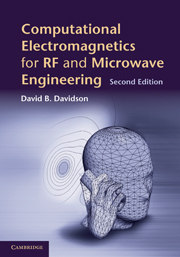Book contents
- Frontmatter
- Dedication
- Contents
- Preface to the second edition
- Preface to the first edition
- Acknowledgements
- To the reader
- List of notation
- 1 An overview of computational electromagnetics for RF and microwave applications
- 2 The finite difference time domain method: a one-dimensional introduction
- 3 The finite difference time domain method in two and three dimensions
- 4 A one-dimensional introduction to the method of moments: modelling thin wires and infinite cylinders
- 5 The application of the FEKO and NEC-2 codes to thin-wire antenna modelling
- 6 The method of moments for surface modelling
- 7 The method of moments and stratified media: theory
- 8 The method of moments and stratified media: practical applications of a commercial code
- 9 A one-dimensional introduction to the finite element method
- 10 The finite element method in two dimensions: scalar and vector elements
- 11 The finite element method in three dimensions
- 12 A selection of more advanced topics in full-wave computational electromagnetics
- Appendix A The Whitney element
- Appendix B The Newmark-β time-stepping algorithm References
- Appendix C On the convergence of the MoM Reference
- Appendix D Useful formulas for simplex coordinates
- Appendix E Web resources
- Appendix F MATLAB files supporting this text
- Index
- References
10 - The finite element method in two dimensions: scalar and vector elements
Published online by Cambridge University Press: 05 July 2014
- Frontmatter
- Dedication
- Contents
- Preface to the second edition
- Preface to the first edition
- Acknowledgements
- To the reader
- List of notation
- 1 An overview of computational electromagnetics for RF and microwave applications
- 2 The finite difference time domain method: a one-dimensional introduction
- 3 The finite difference time domain method in two and three dimensions
- 4 A one-dimensional introduction to the method of moments: modelling thin wires and infinite cylinders
- 5 The application of the FEKO and NEC-2 codes to thin-wire antenna modelling
- 6 The method of moments for surface modelling
- 7 The method of moments and stratified media: theory
- 8 The method of moments and stratified media: practical applications of a commercial code
- 9 A one-dimensional introduction to the finite element method
- 10 The finite element method in two dimensions: scalar and vector elements
- 11 The finite element method in three dimensions
- 12 A selection of more advanced topics in full-wave computational electromagnetics
- Appendix A The Whitney element
- Appendix B The Newmark-β time-stepping algorithm References
- Appendix C On the convergence of the MoM Reference
- Appendix D Useful formulas for simplex coordinates
- Appendix E Web resources
- Appendix F MATLAB files supporting this text
- Index
- References
Summary
Introduction
In the preceding chapter, an introduction to the finite element method was provided by way of a one-dimensional problem. In the course of that development, a number of core features of a typical finite element analysis and FEM code were presented, including the concepts of the variational boundary value problem (VBVP) — which is solved instead of the original differential equation, the importance of boundary conditions, assembly-by-elements, rates of convergence and higher-order elements. Whilst very useful indeed for didactic purposes, the one-dimensional introduction does not permit one to address a number of important issues, which can indeed be addressed in two dimensions. The most important of these is the necessity of a new type of element, originally known as an edge element, but now generally called a vector element, where the degrees of freedom no longer reside at element nodes, but rather along element edges (in their lowest-order form, as edge elements), on faces, and (in three dimensions) over the volume of the element.
However, before vector elements are addressed, there are still some very useful topics to discuss with scalar (nodal) elements in two dimensions, and the first part of this chapter will revisit some topics which were deferred from the previous one, as well as demonstrate an application of a two-dimensional solver to a quasi-static problem (the quasi-TEM analysis of a microstrip transmission line), where the electric fields can be adequately represented as the gradient of the scalar electric potential ø.
Information
- Type
- Chapter
- Information
- Computational Electromagnetics for RF and Microwave Engineering , pp. 342 - 406Publisher: Cambridge University PressPrint publication year: 2010
